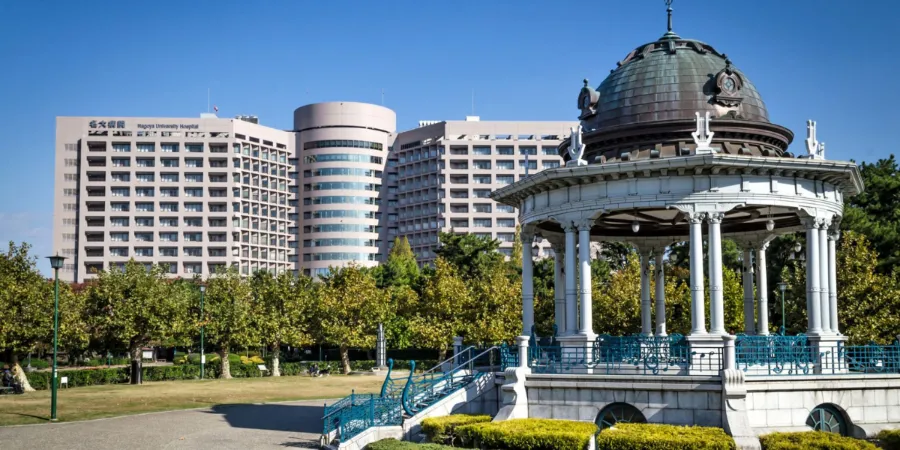Nagoya University - Should you enroll?
Nagoya University (Meidai) Japan is a university with great attraction to international students. So what do you already know about this university? Let's learn more about this university with GoEMON!

I. Introduction to Nagoya University
Nagoya University(名古屋大学), also abbreviated to Meidai, is among the top famous universities in Japan. It is also one of the 7 Imperial Universities, which are the universities that were established by the Empire of Japan from 1886 to 1939.
The university resides in Nagoya City, Aichi Prefecture - the 3rd largest industrial city in Japan.
There are 3 campuses: Higashiyama, Daiko, and Tsurumai, in which Higashiyama is the largest campus that most of the students frequent. Daiko and Tsurumai campuses are mostly for students enrolling in Health or Medicine related majors.
The school takes in roughly 15.000 students each year, 30% of which are international students (including international students studying in Japanese and those studying in English). In comparison with other Japanese universities (not including international universities), it is safe to say that there are quite a lot of international students here. Thus, the university is relatively famous in the international community.
Nagoya University is prominent in its natural science and research-related majors. 4 of the university’s professors have received the Nobel prize, ranking 3rd in Japan (only after Tokyo University and Kyoto University).
II. International programs at Nagoya University
Overall, there are 2 international programs at Nagoya University:
(1) International programs where students would be studying at the university
(2) International programs (exchange programs) where students would be studying at a university in another country
For type (2), its information and participation methods vary depending on the major one is affiliated with, so this article would only focus on type (1).
Within type (1), generally speaking, there are 2 main programs, which are also the university’s most famous international programs: G30 and NUPACE.
Overall, both are international programs that give international students the chance to study in Japan. Following are the differences between the two programs:
- G30: is an undergraduate program that is conducted entirely in English for international students. Students would start their school year in the fall (September - October) and study there for 4 years. The majors can be roughly divided into 2 main types, namely STEM (Engineering, Science, Biology, Chemistry, etc.) and Social Science and Humanities (Law, Economics, and Japan in Asia studies).
- NUPACE: is an exchange program between Nagoya University and other International universities, in which students from said international universities would be going to Japan to study at Nagoya University for from 4 to 12 months. Students would have the chance to choose either to start their school year in the fall semester (September - October) or the spring semester (April).
III. What are the courses like?
- G30: In the first year, students will have to take classes that can be divided into 3 main credit groups: Language (compulsory Japanese for all majors and non-compulsory English for several majors), Liberal Arts, and Specialized Courses (limited number of courses).
- In the second year, most students will finish their Liberal Arts credits and focus more on their Specialized courses (with more classes available).
- The third year will be composed of mostly only Specialized courses, and students will have to fulfill their credit requirements and focus on writing their graduation thesis (for Social Science and Humanities Majors) or graduation research (for STEM Majors).
- With regards to specialized courses, that of STEM majors are mostly lab work, whereas that of Social Science and Humanities majors would be lectures.
- NUPACE: Overall, NUPACE students would be taking the same courses as the G30 students. Additionally, students can also choose to take classes in Japanese (the same ones as the Japanese students) if their Japanese language proficiency is good enough.
IV. Thoughts shared by a current Nagoya University International student:
Thoughts shared by a student currently enrolling in the G30 International Program at Nagoya University, Japan.
“I am enjoying my life to the fullest studying here in the G30 International Program! The international community, as well as the community of those with the same nationality, are all very nice and friendly. I received a lot of help and support from everyone while slowly getting used to living and studying here.
In terms of education, I believe that there is no need to say much since one can probably tell after looking at the university’s ranking, as well as its fame as one of the seven Imperial Universities.
The professors are all very caring, friendly, and thorough with their teaching. They also encourage students to ask a lot of questions and would set office hours so that students can come to their office if they need to ask anything, or set their own schedule with them via mail.
For G30, as each major only have roughly 5 to 7 students each year, the students are usually rather close to their professors.
My advice to those wanting to enter the university is that the workload is pretty heavy, especially for Engineering Majors. Therefore, it might be difficult at first to find the balance between life and study. However, I believe that this is not much of a big issue, as the community here is always more than willing to support you! ”
Above was the guide on Nagoya university and some comments shared by a current G30 International Student studying here. We hope that the article was useful to you!
If you have any questions, feel free to comment down below!